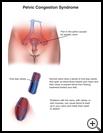
Pelvic Congestion Syndrome
________________________________________________________________________
KEY POINTS
- Pelvic congestion syndrome is a painful condition that may be caused by varicose veins located in a woman’s ovaries, pelvic area, and groin.
- Treatment may include medicines or other therapies that block or seal the veins.
- Follow the full course of treatment prescribed by your healthcare provider. Ask your provider what symptoms or problems you should watch for and what to do if you have them.
________________________________________________________________________
What is pelvic congestion syndrome?
Pelvic congestion syndrome (PCS) is a long-term (chronic) pain in your pelvis, which is the lower belly area between your hips. A woman’s pelvis contains:
- Your ovaries, fallopian tubes, uterus, cervix, and vagina, which are part of your reproductive system
- Your bladder, ureters, and urethra, which are part of your urinary system
- Your intestines, rectum, and anus, which are part of your digestive system
PCS can happen at any time in adulthood. PCS is sometimes called pelvic venous congestion syndrome.
What is the cause?
PCS may be caused by varicose veins located in a woman’s ovaries, pelvic area, and groin. Varicose veins are veins that are swollen or stretched. They may look blue under the skin. Varicose veins are usually in the legs, but with PCS, the veins are inside the pelvic area, genitals, vagina, and upper thighs.
When the muscles in your body tighten and relax, they help to return blood to your heart through the veins. To help this process, the veins have a series of one-way valves in them. The valves open as blood flows toward your heart and then close to prevent blood from flowing backward toward your feet. Problems with the veins, with valves, or with muscles can keep the blood from moving up toward your heart. The blood backs up in your veins and causes them to swell or stretch. These swollen veins are varicose veins.
Varicose veins in the pelvis may be caused by:
- Pregnancy when the baby puts pressure on the large veins in the belly and pelvic areas causing blood to back up
- Having many pregnancies
- Being overweight or obese, which may put pressure on the veins
- A congenital problem with the blood vessels, which means that it’s a problem that you were born with
What are the symptoms?
Symptoms may include:
- Pain that has lasted longer than 6 months
- Pain with sitting or standing for a long time
- Pain that gets better when you lie down
- Pain during or right after vaginal sex
- Pain or unusual bleeding during your menstrual period
- Varicose veins on upper thighs, genitals, or buttocks
- Swollen genitals or vagina or uneven shape to the genitals
- Painful belly
- Backache
- Vaginal discharge
- Low energy or depression
How is it diagnosed?
Your healthcare provider will ask about your symptoms and medical history and examine you. You may have tests or scans to check for other possible causes of your symptoms. Some of the symptoms of PCS may be the same as other problems with your reproductive organs.
Tests may include:
- Blood tests
- Pelvic ultrasound, which uses sound waves to show pictures of your pelvic organs
- CT scan, which uses X-rays and a computer to show detailed pictures of your pelvic organs
- MRI, which uses a strong magnetic field and radio waves to show detailed pictures of the pelvis. Sometimes, your healthcare provider injects a small amount of radioactive chemical into your blood to help show the shape of your veins.
- Laparoscopy, which uses a small lighted tube put into the belly through a small cut to look at the organs and tissues inside the belly
- Venography, which is a series of X-rays taken after your healthcare provider injects a small amount of contrast dye into your blood to help show the shape of your veins
PCS may be related to varicose veins in your legs, especially if they have come back after you had surgery to treat them.
How is it treated?
Treatment may include:
- Hormone medicine and pain medicine
- Embolization is a procedure in which a thin, flexible tube (catheter) is put into a blood vessel in your groin and guided up to the vein. The vein is then blocked using small pieces of plastic, metal, or other material.
- Ablation is a procedure that uses radio waves, heat or extreme cold, or chemicals to close the veins.
- Sclerotherapy uses an irritating liquid that your healthcare provider injects into your veins. This causes the veins to close and forces the blood to flow through other, healthier veins.
How can I take care of myself?
Follow the full course of treatment prescribed by your healthcare provider. In addition:
- Exercise as recommended by your healthcare provider.
- Avoid wearing control-top pantyhose, leg garters, and other tight-fitting garments.
- Keep a healthy weight. If you are overweight, try to lose some weight. Losing weight can help to lessen the pressure on the enlarged veins.
- If you smoke, try to quit. Smoking increases the risk for blood clots that can block the flow of blood in your veins.
Ask your provider:
- How and when you will get your test results
- If there are activities you should avoid and when you can return to your normal activities
- How to take care of yourself at home
- What symptoms or problems you should watch for and what to do if you have them
Make sure you know when you should come back for a checkup. Keep all appointments for provider visits or tests.

